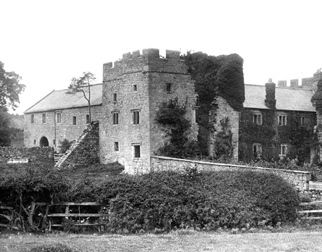
| Blencowe Families’ Association Newsletter | Vol. 24 No. 2 May 2009 |
We have read several varied histories of Blencow Hall. The following is one recorded in 1906 showing there has been a fascination with ‘our’ building for over 100 years. Ruth Jenkins found this one.

In the 21st Edward.III., 1347, the King granted to Adam de Blencowe the enclosures of "Calnethwayt and Braythwaythouses " in the Royal Forest of Inglewood ; the King further granted to him, eleven years afterwards, 1358, all the lands in Greystoke, Blencowe, and Newbiggin which had belonged to John Riddall. This Adam must have greatly distinguished himself under William, baron of Greystoke, during the Black Prince's invasion of France, for we find a curious charter dated from Morpeth Castle, the 26th day of February, 1357, in which the baron granted to him by warrant the use of his own arms to be borne on a bend as an augmentation of honour ˇviz., on a shield sable a bend barred argent and azure charged with 3 chaplets of roses gules. In later years the family bore azure, a bend argent charged with 3 chaplets of roses gules, quartered with their original paternal coat, gules a quarter argent.
We do not know where the early homestead of the family was situated; but Dr. Burn in his History suggests that it may have been at Great Blencow, on the other side of the river, and mentions the ruins of an old tower as existing there in his day.
The northern tower of this present building is the oldest portion, but there are no architectural features to denote its age. Rather, the lack of them helps us to place it at a very late period. The internal width is only twelve feet, the walls are of various thicknesses, the basement is not vaulted, the newel staircase is built out in an adjoining turret, whilst the rooms above, instead of being (as usually) the full size of the tower, are divided by a partition with fireplaces in each apartment. Moreover, the label bosses over the second story windows facing the courtyard bear the initials "H.B." and a fleur-de-lis, the initials of the builder of the centre block; and more noteworthy still are the rude Ionic capitals carved on the label bosses over the first story window, almost suggesting a touch of the Renaissance period.
I am inclined therefore to disagree with Dr. Taylor in thinking that the tower was an early one built for defensive purposes, but would rather suggest that it was built, as we know many towers were, in imitation of the border peles about the beginning of the sixteenth century.
We gain more certain ground, however, when we come to examine the central block, for here the splendid custom of inscribing a stone with the name, date, and arms of the builder and placing it over the front door tells its true tale. In the centre of the lintel we find the paternal coat of arms ˇ viz., gules a quarter argent, and in raised Roman capitals the inscription
The late Thomas Lees made the following note upon this, saying that Anthony Blencowe, the grandfather of Sir Henry, married Winifred, daughter of Thomas Dudley of Yanwath, and thus the Blencowes were related to Lord Guildford Dudley, the husband of the unfortunate Lady Jane Grey. On the night before her execution Lady Jane wrote an exhortation at the end of a New Testament which she sent to her sister Lady Catherine Grey, in which are these words: — “Live still to die, that you by death may purchase eternal life.” “May not” he says, “this inscription be an echo of this?” Whither (are we going)? To live (is) to die. To die (is) life (eternal).
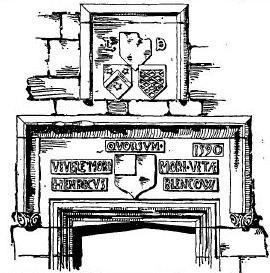
|
| The area above the front door lintel |
Above the lintel there is a carved panel protected by a square-framed label, which contains the initials "H.B." and three shields. The upper shield, which probably once contained the Blencow arms, has been defaced. Dr. Haswell tells me the tradition is that Dugdale on his Visitation of 1615 disallowed the arms, and had them then and there defaced; a very likely tradition, as Dugdale carefully omits to mention the family amongst those entitled to bear arms. Below, the dexter shield bears or a chevron azure between 3 mullets for Crackenthorpe; whilst the sinister shield bears a chief and fret, probably for Curwen.
Dr. Haswell notes: “Richard Blencow, mentioned among the gentlemen liable to Border service in 1543, married .... Curwen. And in another place I find the same Richard to have married Appolin [Apollonia?], afterwards wife of W. Allonby of Allonby.
The doorway gives entrance to a small staircase vestibule, from which a doorway on the left opens into the dining room, measuring 23 x 18 feet, from which another door leads into a small parlour, 17 x 8 feet; whilst a doorway on the right opens from the vestibule into the kitchen, where the fire was set back beneath an elliptical arch of nearly ten feet span.
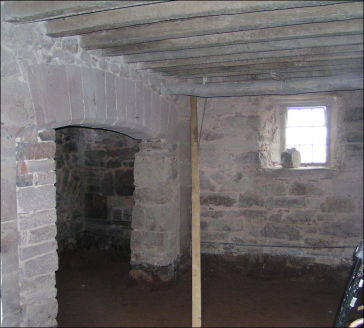
|
| A large fireplace elsewhere in the Hall |
The interesting thing about this central block is that whilst the inner or courtyard wall is some 4 feet thick, the outer one is only 2 4 feet thick, showing that it has been rebuilt. From which evidence it would seem that it was this outer side that, according to tradition, was battered with cannon by a detachment of the Parliamentary army.
The late Thomas Lees makes the following note: "General Lambert in command of the Parliamentary forces took Penrith on the 15th June, 1648, and made it his headquarters for a month. Detachments of his army took Greystoke, Rose, and Scaleby Castles; as Blencow Hall lay in the direct way from Greystoke to Rose, it seems most likely that it was battered by Major Cholmley on this occasion."
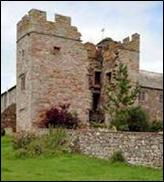
Now Henry Blencow had become a man of some considerable importance. He married for his first wife Jane, the daughter of Sir William Musgrave, and for his second wife Grace, the sister of Sir Richard Sandford of Howgill Castle in Westmorland. In the year 1617 he was knighted by James I; twice over he was appointed High Sheriff of Cumberland, and finally he died in 1635. To cope therefore with the responsibilities of these added dignities, Sir Henry found it necessary again to enlarge his dwelling, which he did by adding the southern tower and wing.
Fortunately this is proved by Edmund Sandford, who in his Cursory Relation of the Antiquities and Familys of Cumberland writ about the year 1675, says: "Blencowe, the seat of an ancient squire family, and one knight of late, Sir Henry Blencow, grandfather of the now Squire. Blencow made it a very fair house of two towers, & c." The principal feature about this wing is the extraordinary projection of the buttress, found on the southern elevation, supporting the thrust of the ingle-nook arch.
Dr. Taylor points out a building at the rear of the courtyard, which he calls the chapel, and where a portion of a Gothic window can still be seen. I find it difficult, however, to believe that this was the original site of a private chapel, which could only be approached by crossing the court. May it not rather be a remnant taken from a chapel that at one time was situated, say, in the southern tower, and which has since been removed and placed as an ornamental feature to decorate a necessary outbuilding that happened to be opposite the front door?
Reference: Transactions of the Cumberland & Westmorland Antiquarian & Archaeological Society Vol. VIL New Series. Editor W. G. Collingwood, M.A., F.S.A. (1907). Kendal: Printed by Titus Wilson, Highgate, 1907
Ruth Jenkins, Suffolk
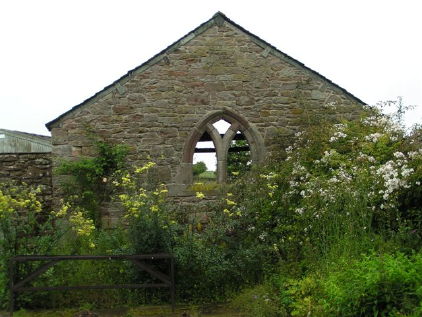
|
| Still there — the Gothic window at western end of old chapel as photographed by Allen Blincoe in 2007 just on 100 years after this article was written |
| Blencowe Families’ Association | Newsletter Archive | Vol. 24 No. 2 May 2009 |